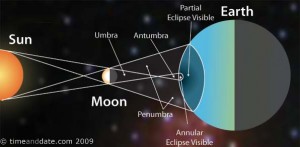 A solar eclipse will occur in Nigeria today< Thursday, September 1, between the hours of 7:15am and 10:03am with slight variations in actual timing across the country, the National Space Research and Development Agency (NSRDA) said.
A solar eclipse will occur in Nigeria today< Thursday, September 1, between the hours of 7:15am and 10:03am with slight variations in actual timing across the country, the National Space Research and Development Agency (NSRDA) said.
A press statement by the Head of Media and Corporate Communications, Dr Felix Ale, appealed to the general public not to panic or attach any spiritual interpretations to this event. He said the eclipse cannot be observed with naked eyes, as this could cause damage.
In the Federal Capital Territory Abuja, there will be a partial eclipse, with an obscurity of 60 per cent, and the first contact at about 7:17am, with maximum eclipse at 8:32am and end at 10:00am.Lagos will experience its first contact with the eclipse at 7:15am, with a maximum eclipse occurring at 8:32am and ending at about 10:00am. The Agency has arranged a viewing centre tomorrow to enable members of the public, pupils and students from various schools to view the eclipse using specially designed viewing instruments provided by the space Agency.
The viewing centre which has been set up by the Agency will be open to the public on Thursday 1st September, 2016 from 6:45am for school pupils and students to observe the annular eclipse as part of its continuous programmes to expose Nigerians and students to matters concerning astronomical environment.
The moon’s dark silhouette will glide across the face of the sun on September 1, giving most of equatorial Africa a rare view of an annular solar eclipse.
A total solar eclipse happens when the moon is close enough to Earth that it seems to completely cover up the sun. During an annular eclipse, though, the moon is farther from Earth and appears to be smaller than the visible disk of the sun, so it does not cover up our star completely. Instead, for a few minutes the sun looks like a striking annulus, or ring, which is why an annular eclipse is also often called a ring of fire.
Here’s everything you need to know about this week’s annular eclipse.
Where are the best places to see the full ring of fire?
Observers will be able to see the entire annular eclipse from a strip of land about 62 miles wide that starts in Gabon on Africa’s west coast and runs down through the Republic of the Congo, the Democratic Republic of the Congo, Tanzania, and Mozambique. The eclipse path will also cross the islands of Madagascar and Réunion off Africa’s east coast.
In Gabon, the eclipse begins at 8:39 a.m. local time, and the burning ring will reach its peak at 10:06 a.m. The eclipse will make its final landfall over Réunion at 2:09 p.m. local time.
The absolute best views will be in southern Tanzania, where viewers will see the eclipse last for its longest duration of three minutes and six seconds.
Will people in other places see a partial eclipse?
While the full eclipse path is relatively narrow, observers in a much broader track stretching for thousands of miles will be able to see the moon take a bite out of the solar disk.
This striking partial eclipse will be visible across most of the African continent, including Morocco and Egypt, and in the southern part of the Arabian Peninsula. Viewers in parts of Europe will also be able to enjoy the show, with the moon covering about 50 percent of the sun for people in Italy and around 90 percent of the sun for folks in Iceland, Scotland, Finland, and Norway.
Check out the timetables at EclipseWise.com for specific viewing hours in cities across Africa.
What is the best way to watch this eclipse?
Even though the solar face will seem to be covered up, you should NEVER look directly at the sun without proper eye protection. If you are using a telescope or camera, astronomers recommend using a professionally manufactured solar filter to avoid damaging ultraviolet and infrared radiation. You can also watch with special eclipse viewing glasses that sufficiently reduce the sun’s brightness and filter out its harmful rays.
Eclipse fans can also get indirect views of the event by building an eclipse viewer, which projects an image of the sun onto a flat surface.
In addition, armchair astronomers around the world can watch the eclipse by visiting the Internet-based space tracking service SLOOH. The organization will be broadcasting the eclipse live online starting at 2:45 a.m. ET.
What if I miss this eclipse?
The next solar eclipse will also be a ring of fire, and it will occur on February 26, 2017. During that event, the moon’s shadow will cross eastern South America.
And the next total solar eclipse will grace our skies in August 2017, when the moon’s shadow will glide across a large part of the continental United States for the first time in 37 years.
 YouNewsng Discover. Succeed. Enjoy
YouNewsng Discover. Succeed. Enjoy








